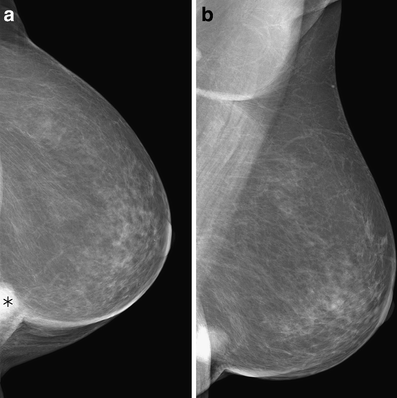Impact of breast density on computer-aided detection in full-field digital mammography
- PMID: 16741664
- PMCID: PMC3045151
- DOI: 10.1007/s10278-006-0592-x
Impact of breast density on computer-aided detection in full-field digital mammography
Abstract
The goal of this study was to evaluate the performance of a computer-aided detection (CAD) system in full-field digital mammography (Senographe 2000D, General Electric, Buc, France) in finding out carcinomas depending on the parenchymal density. A total of 226 mediolateral oblique (MLO) and 186 craniocaudal (CC) mammographic views of histologically proven cancers were retrospectively evaluated with a digital CAD system (ImageChecker V2.3 R2 Technology, Los Altos, CA, USA). Malignant tumors were detected correctly by CAD in MLO view in 84.85% in breasts with parenchymal tissue density of the American College of Radiology (ACR) type 1, in 70.33% of the ACR type 2, in 68.12% of the ACR type 3, and in 69.70% of the ACR type 4. For the CC view, similar results were found according to the ACR types. Using the chi-square and McNemar tests, there was no statistical significance. However, a trend of better detection could be seen with decreasing ACR type. In conclusion, there seems to be a tendency for breast tissue density to affect the detection rate of breast cancer when using the CAD system.
Figures


Similar articles
-
Computer-aided detection in full-field digital mammography: detection in dependence of the BI-RADS categories.Breast J. 2006 Jan-Feb;12(1):16-9. doi: 10.1111/j.1075-122X.2006.00185.x. Breast J. 2006. PMID: 16409582
-
[Impact of breast density on computer-aided detection (CAD) of breast cancer].Zhonghua Zhong Liu Za Zhi. 2012 May;34(5):360-3. doi: 10. 3760/cma.j.issn.0253-3766.2012.05.009. Zhonghua Zhong Liu Za Zhi. 2012. PMID: 22883457 Chinese.
-
[Digital full field mammography: comparison between radiographic direct magnification and digital monitor zooming].Radiologe. 2002 Apr;42(4):261-4. doi: 10.1007/s00117-002-0733-2. Radiologe. 2002. PMID: 12063732 German.
-
Follow-up of B3 breast lesions without residual microcalcifications post vacuum-assisted biopsy, can contrast-enhanced digital mammography help?Breast J. 2020 Feb;26(2):299-302. doi: 10.1111/tbj.13598. Epub 2019 Sep 4. Breast J. 2020. PMID: 31486197 No abstract available.
-
Tumour detection rate of a new commercially available computer-aided detection system.Eur Radiol. 2001;11(12):2454-9. doi: 10.1007/s003300101079. Epub 2001 Sep 5. Eur Radiol. 2001. PMID: 11734939
Cited by
-
A statistical approach for breast density segmentation.J Digit Imaging. 2010 Oct;23(5):527-37. doi: 10.1007/s10278-009-9217-5. Epub 2009 Jun 9. J Digit Imaging. 2010. PMID: 19506953 Free PMC article.
-
Comparative Study on Local Binary Patterns for Mammographic Density and Risk Scoring.J Imaging. 2019 Feb 1;5(2):24. doi: 10.3390/jimaging5020024. J Imaging. 2019. PMID: 34460472 Free PMC article.
-
Automatic Estimation of Volumetric Breast Density Using Artificial Neural Network-Based Calibration of Full-Field Digital Mammography: Feasibility on Japanese Women With and Without Breast Cancer.J Digit Imaging. 2017 Apr;30(2):215-227. doi: 10.1007/s10278-016-9922-9. J Digit Imaging. 2017. PMID: 27832519 Free PMC article.
-
The message matters: changes to binary Computer Aided Detection recommendations affect cancer detection in low prevalence search.Cogn Res Princ Implic. 2024 Sep 2;9(1):59. doi: 10.1186/s41235-024-00576-4. Cogn Res Princ Implic. 2024. PMID: 39218972 Free PMC article.
-
Thick slices from tomosynthesis data sets: phantom study for the evaluation of different algorithms.J Digit Imaging. 2009 Oct;22(5):519-26. doi: 10.1007/s10278-007-9075-y. Epub 2007 Oct 23. J Digit Imaging. 2009. PMID: 17955296 Free PMC article.
References
-
- Moskowitz M. Screening for breast cancer: how effective are our test? A critical review. CA Cancer J Clin. 1983;33:26–39. - PubMed
-
- Bird RE. Professional quality assurance for mammography screening programs. Radiology. 1990;77:8–10. - PubMed
-
- Chan HP, Doi K, Vyborny CJ, Schmidt RA, Metz CE, Lam KL, Ogura T, Wu YZ, MacMahon H. Improvement in radiologists' detection of clustered microcalcifications on mammograms. The potential of computer-aided diagnosis. Invest Radiol. 1990;25:1102–1110. doi: 10.1097/00004424-199010000-00006. - DOI - PubMed
MeSH terms
LinkOut - more resources
Full Text Sources
Medical
Miscellaneous

